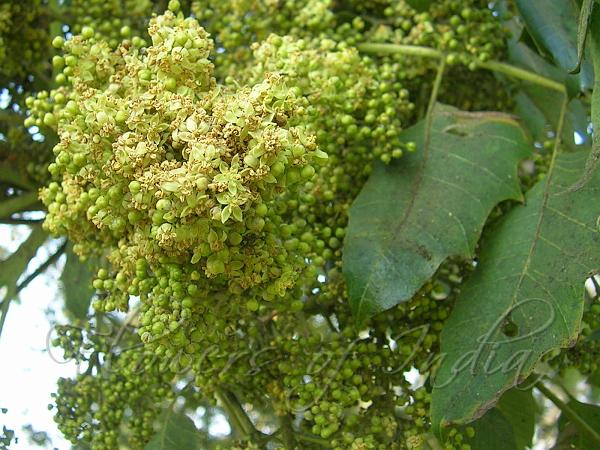|
| Indian Tree of Heaven |
|

|

| File size | 584406 |
| Original date | 3/2/08 3:46 PM |
| Resolution | 2048 x 1536 |
| Flash | Flash did not fire, auto |
| Focal length | 5.4mm |
| Exposure time | 1/98s |
| Aperture | 2.8 |
| Focus Distance | |
| Metering Mode | Partial |
| Camera make | NIKON |
| Camera model | E3700 |
| Sensor type |
|
|
|
|
Photo: |
Botanical name: Ailanthus excelsa Family: Simaroubaceae (Quassia family)
Indian Tree of Heaven is a large deciduous tree, 18-25 m tall; trunk
straight, 60-80 cm in diameter; bark light grey and smooth, becoming
grey-brown and rough on large trees, aromatic, slightly bitter. Leaves
alternate, pinnately compound, large, 30-60 cm or more in length; leaflets
8-14 or more pairs, long stalked, ovate or broadly lance shaped from very
unequal base, 6-10 cm long, 3-5 cm wide, often curved, long pointed, hairy
gland; edges coarsely toothed and often lobed. Flower clusters droop at
leaf bases, shorter than leaves, much branched; flowers many, mostly male
and female on different trees, short stalked, greenish-yellow. Five sepals, 5 narrow petals spreading 6 mm across. Fruit a 1-seeded samara, lance shaped, flat, pointed at ends, 5 cm
long, 1 cm wide, copper red, strongly veined, twisted at the base The genus
name Ailanthus comes from ailanthos (tree of heaven), the
Indonesian name for Ailanthus moluccana.
Flowering: January-March.
Medicinal uses: Bark used in India as a powerful fever-cure and
tonic. Leaves and bark in good repute as a tonic after labor, and the juice
of the leaves and fresh bark employed by the Konkans as a remedy for
after-pains.
Bark used in India as a powerful fever-cure and
tonic. Leaves and bark in good repute as a tonic after labor, and the juice
of the leaves and fresh bark employed by the Konkans as a remedy for
after-pains.
Medicinal uses:
 Bark used in India as a powerful fever-cure and
tonic. Leaves and bark in good repute as a tonic after labor, and the juice
of the leaves and fresh bark employed by the Konkans as a remedy for
after-pains.
Bark used in India as a powerful fever-cure and
tonic. Leaves and bark in good repute as a tonic after labor, and the juice
of the leaves and fresh bark employed by the Konkans as a remedy for
after-pains. | Identification credit: Tabish | Photographed at Nehru Park, Delhi. |
• Is this flower misidentified? If yes,